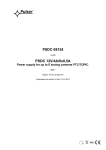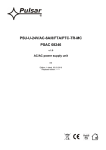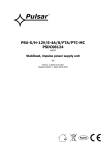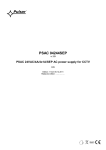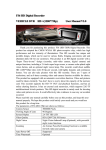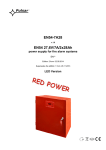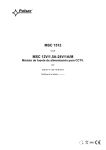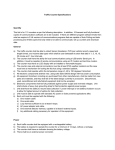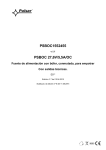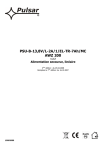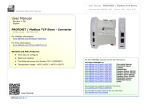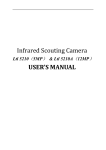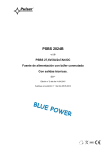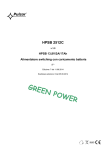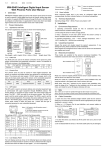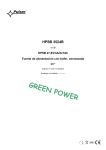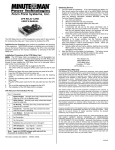Download IF16L - Pulsar
Transcript
The exclusive distributor of AMC products IF16L Digital curtain detector (dual PIR) CODE IF16L In accordance with the EN 50131-2-2 standard USER MANUAL EN Edition: 1 from 10.03.2014 Supercedes the edition: ----------- 1. Introduction The IF16L is a curtain PIR detector for doors and windows protection. It is additionally equipped with: - high power LED (soft switching on and off) - direction detection function - alarm delay circuit - acoustic indication Due to the wide angle coverage and the possibility of limiting the rotation of the width of the PIR beam, the detector can be installed in various configurations (top, bottom or side). 1 2. Installation The detector should be mounted by a qualified installer, holding relevant permits and licenses (applicable and required for a given country) for Intrusion Detection Systems. Follow the basic rules for the installation of Intrusion Detection Systems (pay attention, among others, not to soil or damage the pyroelectric element). The latch system used in the enclosure of the detector eliminates the need for screw connections, so that the detector installation is simple and does not take much time. Perform the following steps to mount the detector: 1. Open the detector by releasing (using thin screwdriver) the latch in the lower part of the enclosure (Fig.1a). 2. Remove the PCB from the base by releasing the locking clip (Fig. 1b). 3. Drill a hole to lead the cable (Fig. 1b). 4. Lead the cables through the hole and connect them to the terminal strip (Fig.2). Description of terminals is presented later in this manual. 5. Mount the lower part of the sensor housing with two screws in the locations shown in Fig. 1b. Make sure that the screw is inside the socket and screws do not touch the PCB. 6. Configure the detector (information on the control elements with a description of the available functions can be found in the following pages). 7. Close the lid of the sensor. 8. Connect the supply voltage and wait until the LED of the sensor stops flashing. Caution! After connecting, the detector needs about 40 seconds for start and calibration. During this time, the alarm cannot be activated. The sensor can be activated again five seconds after each activation. Fig. 1a. The enclosure of the detector. Fig. 1b.The enclosure base of the detector. 2 Fig. 2 PCB of the detector. 3. Configuration of the sensor Both the installation and configuration of the sensor use: 1. Eight-position ON / OFF switch. 2. Floating beam separator and removable lens. Fig. 3 Floating beam separator and removable lens. 3 DIP switch DIP1 Acoustic indication (speaker) DIP2 Optical indication (red LED) DIP3 Sensor range DIP4, DIP5 - type of sensor operation (immediate action / alarm delay) DIP6 High power LED DIP7 Direction detection DIP8 Setting the alarm direction (Fig.2) OFF off ON on off on 2m 3,5m immediate action DIP4-OFF, DIP5-OFF 30 seconds alarm delay DIP4-ON, DIP5-OFF one and half minute alarm delay DIP4-OFF, DIP5-ON two minute alarm delay DIP4-ON, DIP5-ON off on alarm from all directions alarm from one direction* 1 → 2 - alarm 2 → 1 - alarm * For correct use of the direction detection function, properly set up the lens and adjust the beam separator in addition to setting the DIP7 and DIP8 switches (see Fig. 4). Description of functions contained in the table. Acoustic indication (speaker) – DIP1 The sensor has a built-in speaker for acoustic indication Acoustic signaling is activated with the DIP1 dip switch. The type of emitted sound varies depending on the direction. The acoustic signal is also used for signaling other events described below. Optical indication (red LED) – DIP2 The sensor is equipped with a red LED for alarm signaling and informing about other events including alarm delay. Sensor range - DIP3 Selection of sensor range in order to adapt the beam to the protected area. It is possible to set a value of 2 meters or 3.5 meters. Alarm delay (DIP 4 - DIP5) This feature enables alarm delay after the activation of the sensor (available delays: 30 s, 1.5 min., 2 min.). Use the DIP4 or DIP5 switches to set the delay time: DIP4-ON, DIP5-OFF - a delay of approximately 30 seconds, DIP4-OFF, DIP5-ON - a delay of approximately one and half minute, DIP4-ON and DIP5-ON – delay time adds up and is about 2 minutes, DIP4-OFF and DIP5-OFF – immediate action of the sensor. With this feature on, the detector starts the timer after the first activation, which is indicated by rapid flashing of the red LED (Note: The LED must be on, DIP # 2 ON). During the countdown, of the set time - the sensor is blocked and cannot be activated. After the countdown, the LED stops flashing). If is no further activation within 20 seconds, the sensor will be reset. If the sensor will be activated within 20 seconds, an alarm will be generated (NC contact will be opened). This function is used to gain access to the protected area without having to disarm the system. 4 The DIP6 high power LED The detector is equipped with a high power LED. This allows, among others, to use the detector as an emergency lighting lamp (remotely activated when the terminal marked with the "bulb" symbol will be shorted to ground). To implement this function, use the OC output. The light activated in this way lights all the time until the opening of the "bulb" contact from the ground. The light can also be activated by the sensor itself (during its activation), then the lighting time is 40 seconds. To implement this function, set the DIP6 switch to ON position. Additional notes: Turning on the light causes an increase in temperature in the area of the PIR sensor. Therefore, for about 20 seconds the sensor is switched off in order to re-calibrate the thresholds. After this time, the sensor is ready for operation (LED mode). Each new activation of the sensor extends the light duration up to 40 seconds, and alarm recovery time up to 10 seconds. Thanks to this solution the sensor operates correctly even with the LED lamp on. When the LED is turned off, the sensor needs about 20 seconds to calibrate again. When activated during calibration, the detector generates an alarm, after 30 seconds. Caution! The activation must be continuous in order to stop the calibration procedure. Alarm direction detection (DIP7, DIP8) The IF16L detector is equipped with the direction detection function. With this feature on, it is possible to define when an alarm is to be generated. To activate the function, use the DIP7 switch. With the DIP7 switch in OFF position, an alarm is generated regardless of the direction, while with the DIP7 in ON position – an alarm is generated only from one direction. To choose the direction from which the alarm should be generated, use the DIP8 switch (see Fig. 6) With the direction detection function on: - in case of activation from „no entrance” area - an alarm is generated, - in case of activation from „free entrance” area the detector is blocked and starts 2 minutes countdown, which is indicated by the slow blinking of the LEDs (the last 10 seconds are indicated by faster blinking of the LED and acoustic signal). During aforementioned two minutes from the activation, the movement of objects in the field of the sensor operation might not generate an alarm. After this time, the detector is reset and goes into the standby mode if not activated during the countdown. Caution! If the detector is activated during the countdown - the countdown starts from the beginning. This feature allows the user to exit through the protected door, e.g. onto a terrace or to peep through the protected window - without activating an alarm even when the system is armed. However, if the direction (first activation) is from outside to inside, then the detector will activate the alarm. For correct use of the direction detection function, properly set up the lens and adjust the beam separator in addition to setting the DIP7 and DIP8 switches (see Fig. 4). 5 Fig. 4 Beam forming by setting the separator and putting the lens on. Fig. 5 Example of sensor installation. 6 4. Technical data IF16L Power supply Power consumption: Alarm / Standby Current consumption with high power LED on Sensor range Operating angle PIR sensor Lens Alarm signaling time Programmable alarm delay Tamper protection (opening of the detector) Maximum load of the contacts of the relay Maximum load of the contacts of the tamper Operating temperature Storage temperature Electromagnetic immunity (radio frequency interference) RFI LED (walk test) High power LED (additional lightning) In accordance with the standard Protection class Enclosure material Dimensions (H x W x D) Pet immunity 9÷15VDC 12,mA/23mA@13,8VDC 260mA do 2m / 3,5m 11° (no beam separation 165°) 2 elements 6 areas in 1 level 4s YES YES 100mA@40VDC / 16Ω 40mA@30VDC -25°C÷55°C -25°C÷60°C 10V/m (20MHz-1000MHz) YES YES EN 50131-2-2 Grade 2 IP42 ABS 130mm x 37mm x 30mm NO In accordance with the standards: CEI EN 50131-2-2 Grade 2 Class 2 RoHS Additional information The manufacturer takes no responsibility for the defects that result from the damaging, malfunctioning or inability to operate the equipment especially when resulting from failure to comply with the recommendations and requirements contained in the manual. It is necessary to periodically test the signaling device. The majority of Intrusion Detection Systems indicates malfunctioning of the signaling devices and informs the user with an appropriate message on the LCD keypad or LED light on the LED display. In case of such situation, the system installer shall be immediately notified. Testing and control methods of Intrusion Detection Systems are specifically determined by the installer. The IF16L detector was made in accordance with the requirements of the EEC and 99/5/CE directives. The Declaration of Conformity is available at www.pulsar.pl. 7 WEEE LABEL Waste electrical and electronic equipment must not be disposed of with normal household waste. According to the European Union WEEE Directive, waste electrical and electronic equipment should be disposed of separately from normal household waste. GENERAL WARRANTY CONDITIONS 1. Pulsar K. Bogusz Sp.j. (manufacturer) grants a two-year quality warranty for the equipment, starting from the production date. 2. The warranty includes free-of-charge repair or replacement with an appropriate equivalent (selected by the manufacturer) if the malfunction is due to the manufacturer. It includes manufacturing or material defects, provided that such defects have been reported within the warranty period (point.1). 3. The equipment subjected to warranty should be brought to the place of purchase or directly to the main office of the manufacturer. 4. The warranty applies to complete equipment, accompanied by a properly filled warranty claim with a description of the defect. 5. Should the claim be accepted, the manufacturer is obliged to provide warranty repairs, at the earliest convenience, however not later that within 14 days from the delivery to the service centre of the manufacturer. 6. The repair period mentioned in point 5 may be prolonged, if there are no technical possibilities to carry out the repairs, or if the equipment has been conditionally accepted, due to the breaking warranty terms by the claimant. 7. All the services are carried out at the service centre of the manufacturer, exclusively. 8. The warranty does not cover the defects of the equipment, resulting from: - reasons beyond the manufacturer's control, - mechanical damage, - improper storage and transport, - use that violates the operation manual or equipment’s intended use, - fortuitous events, including lightning discharges, power failures, fire, flood, high temperatures and chemical agents, - improper installation and configuration (failure to follow instruction). 9. The warranty is void in case of construction changes and repairs carried out by any unauthorized service center or in case of damage or modifications to warranty stickers and serial numbers. 10. The liability of the manufacturer towards the buyer is limited to the value of the equipment determined according to the wholesale prices suggested by the manufacturer on the day of purchase. 11. The manufacturer takes no responsibility for the defects that result from the damaging, malfunctioning or inability to operate the equipment especially when resulting from failure to comply with the recommendations and requirements contained in the manual. The exclusive distributor of AMC products: Pulsar K. Bogusz Sp.j. Siedlec 150, 32-744 Łapczyca, Poland Phone (+48) 14-610-19-40, Fax (+48) 14-610-19-50 E-mail: [email protected], [email protected] www.pulsar.pl, www.zasilacze.pl 8








